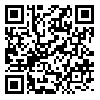Volume 10, Issue 3 (Autumn 2023)
J Prevent Med 2023, 10(3): 290-299 |
Back to browse issues page
Research code: 990255
Ethics code: IR.MUMS.REC.1399.203
Download citation:
BibTeX | RIS | EndNote | Medlars | ProCite | Reference Manager | RefWorks
Send citation to:



BibTeX | RIS | EndNote | Medlars | ProCite | Reference Manager | RefWorks
Send citation to:
Irandost A, Hajali V, Behnejad M, Payvar B, Khosravi Bonjar A, Bazazkahani H. Relationship Between the Results of Laboratory Tests, Lung CT Scan, and Real-time PCR in Suspected or Confirmed COVID-19 Patients in Quchan, Iran. J Prevent Med 2023; 10 (3) :290-299
URL: http://jpm.hums.ac.ir/article-1-672-en.html
URL: http://jpm.hums.ac.ir/article-1-672-en.html
Amin Irandost1 

 , Vahid Hajali2
, Vahid Hajali2 

 , Mahboobeh Behnejad3
, Mahboobeh Behnejad3 

 , Bahareh Payvar4
, Bahareh Payvar4 

 , Ali Khosravi Bonjar5
, Ali Khosravi Bonjar5 
 , Hamid Bazazkahani *6
, Hamid Bazazkahani *6 




 , Vahid Hajali2
, Vahid Hajali2 

 , Mahboobeh Behnejad3
, Mahboobeh Behnejad3 

 , Bahareh Payvar4
, Bahareh Payvar4 

 , Ali Khosravi Bonjar5
, Ali Khosravi Bonjar5 
 , Hamid Bazazkahani *6
, Hamid Bazazkahani *6 


1- Department of Nursing, Quchan School of Nursing, Mashhad University of Medical Sciences, Mashhad, Iran.
2- Department of Neuroscience, Quchan School of Nursing, Mashhad University of Medical Sciences, Mashhad, Iran.
3- Department of Infectious Diseases and Tropical Medicine, Musa ebn Jafar (AS) Quchan Hospital, Mashhad University of Medical Sciences, Mashhad, Iran.
4- Department of Special Care Nursing, Quchan School of Nursing, Mashhad University of Medical Sciences, Mashhad, Iran.
5- Department of Nursing, Emergency and Accident Management Center, Zabol University of Medical Sciences, Zabol, Iran.
6- Department of Psychiatric Nursing, Shirvan School of Nursing, North Khorasan University of Medical Sciences, Bojnurd, Iran.
2- Department of Neuroscience, Quchan School of Nursing, Mashhad University of Medical Sciences, Mashhad, Iran.
3- Department of Infectious Diseases and Tropical Medicine, Musa ebn Jafar (AS) Quchan Hospital, Mashhad University of Medical Sciences, Mashhad, Iran.
4- Department of Special Care Nursing, Quchan School of Nursing, Mashhad University of Medical Sciences, Mashhad, Iran.
5- Department of Nursing, Emergency and Accident Management Center, Zabol University of Medical Sciences, Zabol, Iran.
6- Department of Psychiatric Nursing, Shirvan School of Nursing, North Khorasan University of Medical Sciences, Bojnurd, Iran.
Abstract: (2439 Views)
Objective Due to the rapid spread of COVID-19 worldwide and the lack of a diagnostic method, there is a need to assess the association between the results of existing methods for rapid diagnosis. Therefore, this study aims to assess the relationship between the results of laboratory tests, CT scan, and real-time polymerase chain reaction (RT-PCR) in suspected or confirmed COVID-19 patients in Quchan, Iran.
Methods This retrospective study was conducted on 221 suspected or confirmed COVID-19 patients referred to a hospital in Quchan, Iran. The required information including the results of five blood tests, lung CT scan, and RT-PCR was extracted from the medical records of patients and was analyzed by descriptive statistics, chi-square test, and Cramér’s V statistic in SPSS software, version 19.
Results The mean age of the subjects was 60±11.4 years, and 51.58% were female. Positive blood tests, lung CT scan and RT-PCR were reported in 37.1%, 66.5%, and 32.1%, respectively. It was reported that 76% of patients with positive RT-PCR also had a positive lung CT scan. However, it was not statistically significant based on the chi-square test results. There was a significant relationship between positive RT-PCR and positive blood tests (Cramér’s V=0.186) and between positive blood tests and CT scan ( Cramér’s V=0.231). There was no significant relationship between the positive results of the three diagnostic methods.
Conclusion The sensitivity of lung CT scan to COVID-19 is higher. Due to the negative results of blood tests and RT-PCR in the early stage of the disease, lung CT scan for suspected cases and the repetition of blood tests and RT-PCR can help make a correct COVID-19 diagnosis.
Methods This retrospective study was conducted on 221 suspected or confirmed COVID-19 patients referred to a hospital in Quchan, Iran. The required information including the results of five blood tests, lung CT scan, and RT-PCR was extracted from the medical records of patients and was analyzed by descriptive statistics, chi-square test, and Cramér’s V statistic in SPSS software, version 19.
Results The mean age of the subjects was 60±11.4 years, and 51.58% were female. Positive blood tests, lung CT scan and RT-PCR were reported in 37.1%, 66.5%, and 32.1%, respectively. It was reported that 76% of patients with positive RT-PCR also had a positive lung CT scan. However, it was not statistically significant based on the chi-square test results. There was a significant relationship between positive RT-PCR and positive blood tests (Cramér’s V=0.186) and between positive blood tests and CT scan ( Cramér’s V=0.231). There was no significant relationship between the positive results of the three diagnostic methods.
Conclusion The sensitivity of lung CT scan to COVID-19 is higher. Due to the negative results of blood tests and RT-PCR in the early stage of the disease, lung CT scan for suspected cases and the repetition of blood tests and RT-PCR can help make a correct COVID-19 diagnosis.
Type of Study: Orginal |
Subject:
Special
Received: 2022/11/4 | Accepted: 2023/12/2 | Published: 2023/10/1
Received: 2022/11/4 | Accepted: 2023/12/2 | Published: 2023/10/1
Send email to the article author
| Rights and permissions | |
 |
This work is licensed under a Creative Commons Attribution-NonCommercial 4.0 International License. |





 hums.ac.ir
hums.ac.ir